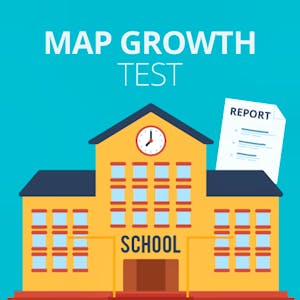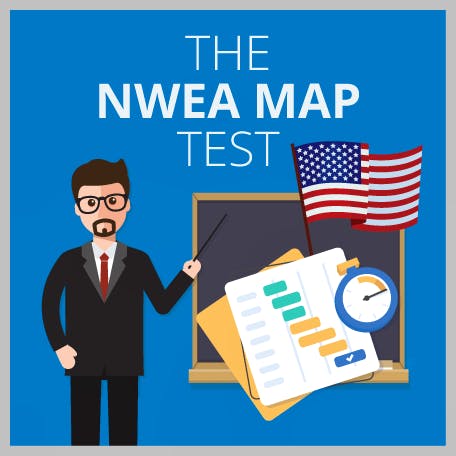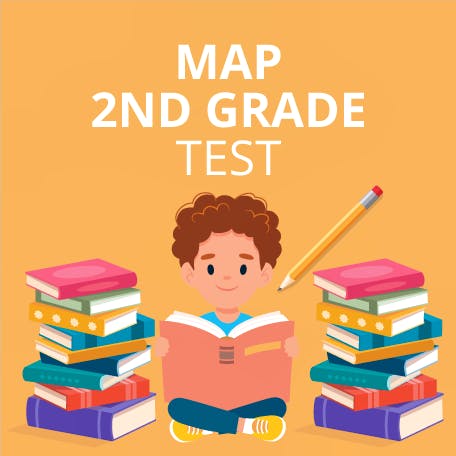MAP Test Scores: Understand Your MAP Score
Updated November 29, 2023


With the MAP Growth Test used in many schools across the United States, MAP (Measures of Academic Progress) scores are an important part of your child’s life.
The MAP testing scores chart a student’s academic growth in a way that highlights areas of excellence and improvement.
It is essential that you understand how NWEA MAP scores are calculated so you can best support your child throughout their learning journey.
This guide will explain how to find and improve your child’s NWEA Map Scores.
Introduction to MAP Test Scores
An increasingly popular way to measure students’ academic progress, MAP scores are calculated using the RIT, or Rasch unIT scale.
This scale measures a student’s score in relation to their score on a previous test to assess how well they have progressed in school.
The score is not a target but rather a benchmark of a student’s academic skill level over a period of time.
Moreover, the RIT value given to a student predicts that at that specific difficulty level, a student is likely to answer about 50% of the questions correctly.
As the results are scored across an even interval scale, the difference between scores remains consistent whether a student scores high or low.
How to Find the NWEA Map Scores
A student’s MAP Score is displayed using graphs, tables, and descriptors.
To find your NWEA Map Scores, you can log into the MAP Administration and Reporting Center website. Under the MAP reports is Student Progress, and reports for each academic year term.
When a student takes the MAP test online, their MAP scores are immediately available to view.
You can use the current NWEA MAP RIT percentiles to interpret the scores, but the best way to get more information on the test results is to talk to your child’s school.
Their teacher will be knowledgeable about the meaning of MAP scores and can explain them in relation to your child’s academic performance.
What Is in the MAP Scores Report?
The MAP Test Scores Chart contains a lot of data and can be difficult to interpret. This section will explain what each part of the chart means.
After a student takes the MAP test, parents and guardians will receive a Student Progress Report.
This displays the student's most recent MAP Growth Test scores as well as previous scores.
The report aims to show a student’s educational progress as a whole and from one semester to the next.
The report will cover science, reading, language usage, and math MAP test scores.
RIT Scores
The report will show the student’s RIT Scores for each topic they are tested in.
These are typically:
- Reading
- Language usage
- Science
- Math
Each score represents a student's achievement level at any given moment. They can be used to measure their academic growth over time.
In addition, the higher the score, the more achievement the student has in the subject.
Student Growth
A student’s growth projection depends on the following factors: grade, subject, and starting RIT score.
Individual growth also indicates the average growth for all students who are in the same grade, in the same subject, with the same starting RIT score.
For example, if a student's growth projection from summer to winter is 6 RIT points, this means that of all students in the same grade and subject and starting at the same initial RIT, the average growth was 6 RIT points.
Student Percentile
A percentile rank indicates how well a student performs compared to the students in the specific sample group who are in the same grade and tested on the same subject.
For example, if a student scores in the 40th percentile, this means that they scored as well as, or better than, 40% of students in the sample group.
It also means that 60% of students in the sample group exceeded this score.
Individual Student Progress
MAP Growth tracks a student’s progress over time throughout their school journey. Each MAP score from every test taken will appear on a student’s MAP report for easy comparison.
District Grade Level Mean
The District Grade Level Mean RIT is the average score of students in the district who are in the same grade and term and tested on the same subject.
This data can be used to compare your results to other students in the district.
Norm Grade Level Mean RIT Score
In contrast to the District Grade Level Mean, the Norm Grade Level Mean RIT Score indicates the average MAP test scores of students in the same grade and term tested on the same subject from the Norms study.
This sample test provides data representative of schools across the USA.
Future Progress Prediction
As well as recording a student’s past performance and their progress so far, MAP test scores can also be used to predict their future progress.
The prediction is calculated by adding together the current RIT score and the Growth Projection.
This prediction estimates a student’s MAP score on future tests.

If you want 12-month access to all the practice resources for this test, our partner TestPrep-Online.com offers a Family Membership.
Family Membership gives you access to all the TestPrep-Online resources for the next 12 months. You will also get two separate accounts, which can be very helpful if you have two children preparing for their tests.
How Are the MAP Testing Scores Calculated?
The MAP testing scores are calculated using the RIT scale, which is different from traditional percentage or percentile scores.
It is a developmental scale that measures growth over time, allowing for comparisons of a student's performance across different grade levels.
The RIT scale is not based on a student's age or grade. Instead, it is based on a student's difficulty answering questions correctly.
At the beginning of the MAP test (which can be taken in subjects such as reading, language usage, mathematics, and science) is a set of calibration questions. They are of average difficulty and are used so the system can continuously adjust the difficulty level.
After the test, students will receive their MAP scores. There is no minimum or maximum score.
Rather, the RIT scale can be used to measure academic achievement between individuals.
For example, a student with a RIT score of 200 is performing at a higher level than a student with a score of 180. The scale allows measuring academic progress over time as it is easy to see improvement in scores.
The MAP scores can be difficult to understand, so percentile rankings are used to make the results easier for students, parents, and teachers to read.
These percentiles compare a student's performance to a nationally representative sample of students in the same grade who have also taken the test. Percentiles produce a simpler metric.
If a student’s percentile rank is 80, this means that they performed better than 80% of the sample group.
MAP tests are adaptive, meaning the difficulty of the questions adjusts based on the student's responses.
If a student answers a question correctly, they receive a slightly more challenging question. If they answer incorrectly, they get an easier one.
MAP Test Scores Chart
The MAP Test Scores Chart contains data that can be used to identify a student’s areas of weakness and improvement. Understanding your child’s report will help you to support them in school.
Below is an example of an NWEA Math score chart that displays the scores of a class from each fall semester from kindergarten through to 12th grade.
| K | 1 | 2 | 3 | 4 | 5 | 6 | 7 | 8 | 9 | 10 | 11 | 12 | Norms Percentile | |
|---|---|---|---|---|---|---|---|---|---|---|---|---|---|---|
| NWEA Fall | 156 | 178 | 196 | 213 | 225 | 230 | 236 | 240 | 247 | 251 | 250 | 254 | 255 | 95 |
| NWEA Fall | 148 | 169 | 188 | 205 | 215 | 223 | 228 | 230 | 236 | 237 | 240 | 242 | 245 | 84 |
| NWEA Fall | 144 | 161 | 182 | 196 | 204 | 215 | 217 | 223 | 225 | 227 | 231 | 233 | 232 | 69 |
| NWEA Fall (median) | 136 | 138 | 155 | 171 | 188 | 199 | 203 | 209 | 215 | 217 | 220 | 223 | 225 | 50 |
| NWEA Fall | 132 | 150 | 166 | 179 | 187 | 201 | 205 | 211 | 206 | 214 | 216 | 213 | 224 | 31 |
| NWEA Fall | 125 | 145 | 156 | 171 | 182 | 191 | 199 | 200 | 201 | 203 | 206 | 205 | 201 | 16 |
| NWEA Fall | 118 | 134 | 146 | 158 | 170 | 175 | 184 | 188 | 191 | 189 | 193 | 195 | 190 | 5 |
This comparative data NWEA score chart also shows the NWEA median which is the average score achieved by the sample group. In this case, we can tell that some students performed better than the median.
Therefore, a 'good' score can be classed as one that is equal to or higher than the median.
How to Improve MAP Test Scores
If your child’s MAP Test scores are lower than the average, do not worry. There are lots of things you can do to improve MAP scores.
Step 1. Make Sure You Understand the Scoring System
It is important that you understand your child’s scores and how they compare to the national average. If you are unclear, be sure to speak with your child’s teacher.
Step 2. Use Previous Tests and Online Practice Tests to Prepare
You can use the growth predictions and previous results as a guide in terms of what areas to focus on. Understanding your child’s strengths and weaknesses can help you to support their learning.
Step 3. Focus On Growth and Improvement
Remember that the MAP Test is not an exam that you can either pass or fail.
It is a measurement of a student’s academic performance throughout their school life.
Having a growth mindset is important to help your child improve year on year.
You can identify how your child is progressing by comparing their kindergarten MAP test scores with their most recent results.
You can improve MAP test scores using several tips. You should ensure you understand the scoring system, focus on improvement, and use practice tests to prepare for each test.
You can check math, language, science and MAP reading scores by logging into the NWEA website. Under MAP reports you will find your child’s MAP results.
The average NWEA score for 8th grade depends on the year and semester that the test is taken. You can find the current average scores on the NWEA website.
A good NWEA score depends on the time of year the test is taken. You can find the current average scores on the NWEA website.
The highest possible NWEA score is typically equal to or greater than the 95% percentile.
A MAP score in the 98th or 99th percentile can be classed as gifted. This means that the student performed better than 98% or 99% of the sample group.
Final Thoughts
The NWEA MAP Test is an important tool schools use to measure students’ progress as they progress through each grade. It is crucial that your child’s academic achievement improves year on year, and the test is a good way to monitor this. You can support your child by helping them to prepare for each test.













